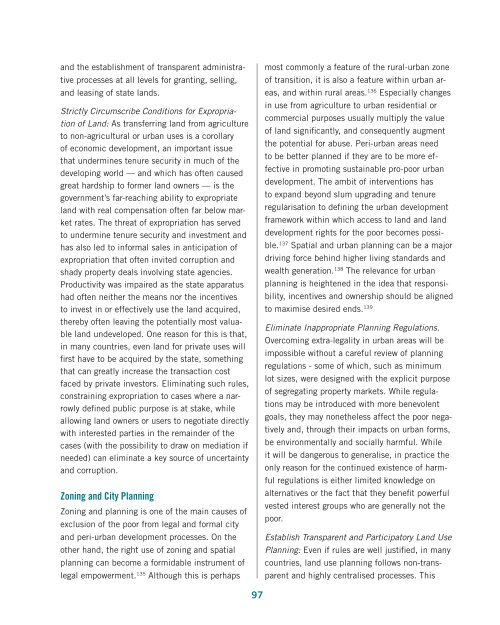Download the file - United Nations Rule of Law
Download the file - United Nations Rule of Law
Download the file - United Nations Rule of Law
You also want an ePaper? Increase the reach of your titles
YUMPU automatically turns print PDFs into web optimized ePapers that Google loves.
and <strong>the</strong> establishment <strong>of</strong> transparent administrativeprocesses at all levels for granting, selling,and leasing <strong>of</strong> state lands.Strictly Circumscribe Conditions for Expropriation<strong>of</strong> Land: As transferring land from agricultureto non-agricultural or urban uses is a corollary<strong>of</strong> economic development, an important issuethat undermines tenure security in much <strong>of</strong> <strong>the</strong>developing world — and which has <strong>of</strong>ten causedgreat hardship to former land owners — is <strong>the</strong>government’s far-reaching ability to expropriateland with real compensation <strong>of</strong>ten far below marketrates. The threat <strong>of</strong> expropriation has servedto undermine tenure security and investment andhas also led to informal sales in anticipation <strong>of</strong>expropriation that <strong>of</strong>ten invited corruption andshady property deals involving state agencies.Productivity was impaired as <strong>the</strong> state apparatushad <strong>of</strong>ten nei<strong>the</strong>r <strong>the</strong> means nor <strong>the</strong> incentivesto invest in or effectively use <strong>the</strong> land acquired,<strong>the</strong>reby <strong>of</strong>ten leaving <strong>the</strong> potentially most valuableland undeveloped. One reason for this is that,in many countries, even land for private uses willfirst have to be acquired by <strong>the</strong> state, somethingthat can greatly increase <strong>the</strong> transaction costfaced by private investors. Eliminating such rules,constraining expropriation to cases where a narrowlydefined public purpose is at stake, whileallowing land owners or users to negotiate directlywith interested parties in <strong>the</strong> remainder <strong>of</strong> <strong>the</strong>cases (with <strong>the</strong> possibility to draw on mediation ifneeded) can eliminate a key source <strong>of</strong> uncertaintyand corruption.Zoning and City PlanningZoning and planning is one <strong>of</strong> <strong>the</strong> main causes <strong>of</strong>exclusion <strong>of</strong> <strong>the</strong> poor from legal and formal cityand peri-urban development processes. On <strong>the</strong>o<strong>the</strong>r hand, <strong>the</strong> right use <strong>of</strong> zoning and spatialplanning can become a formidable instrument <strong>of</strong>legal empowerment. 135 Although this is perhapsmost commonly a feature <strong>of</strong> <strong>the</strong> rural-urban zone<strong>of</strong> transition, it is also a feature within urban areas,and within rural areas. 136 Especially changesin use from agriculture to urban residential orcommercial purposes usually multiply <strong>the</strong> value<strong>of</strong> land significantly, and consequently augment<strong>the</strong> potential for abuse. Peri-urban areas needto be better planned if <strong>the</strong>y are to be more effectivein promoting sustainable pro-poor urbandevelopment. The ambit <strong>of</strong> interventions hasto expand beyond slum upgrading and tenureregularisation to defining <strong>the</strong> urban developmentframework within which access to land and landdevelopment rights for <strong>the</strong> poor becomes possible.137 Spatial and urban planning can be a majordriving force behind higher living standards andwealth generation. 138 The relevance for urbanplanning is heightened in <strong>the</strong> idea that responsibility,incentives and ownership should be alignedto maximise desired ends. 139Eliminate Inappropriate Planning Regulations.Overcoming extra-legality in urban areas will beimpossible without a careful review <strong>of</strong> planningregulations - some <strong>of</strong> which, such as minimumlot sizes, were designed with <strong>the</strong> explicit purpose<strong>of</strong> segregating property markets. While regulationsmay be introduced with more benevolentgoals, <strong>the</strong>y may none<strong>the</strong>less affect <strong>the</strong> poor negativelyand, through <strong>the</strong>ir impacts on urban forms,be environmentally and socially harmful. Whileit will be dangerous to generalise, in practice <strong>the</strong>only reason for <strong>the</strong> continued existence <strong>of</strong> harmfulregulations is ei<strong>the</strong>r limited knowledge onalternatives or <strong>the</strong> fact that <strong>the</strong>y benefit powerfulvested interest groups who are generally not <strong>the</strong>poor.Establish Transparent and Participatory Land UsePlanning: Even if rules are well justified, in manycountries, land use planning follows non-transparentand highly centralised processes. This97
















